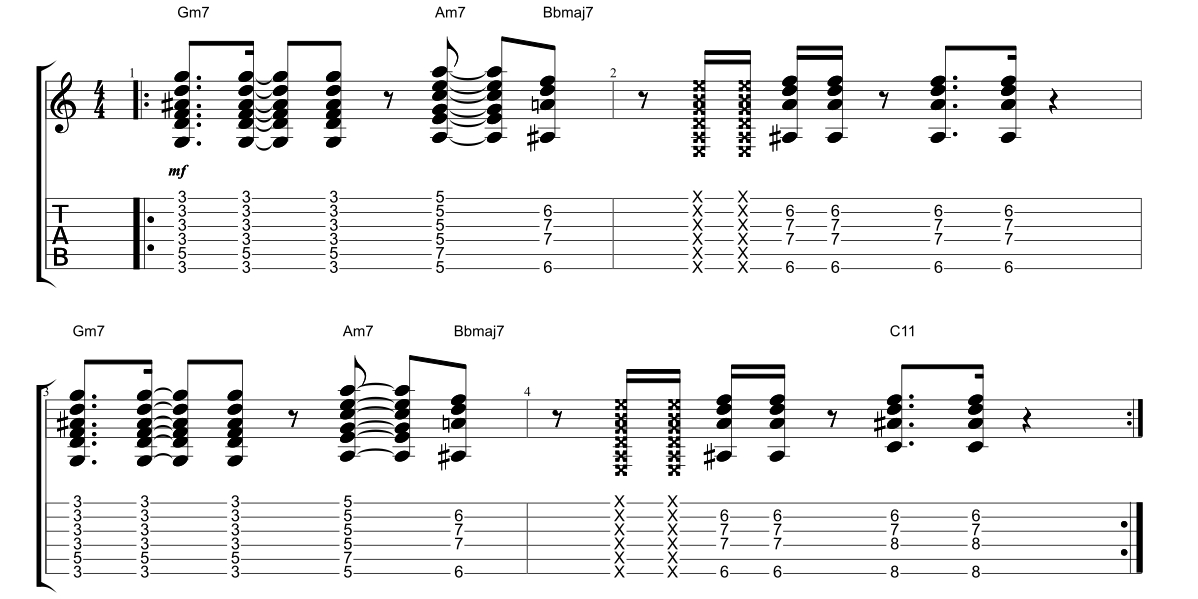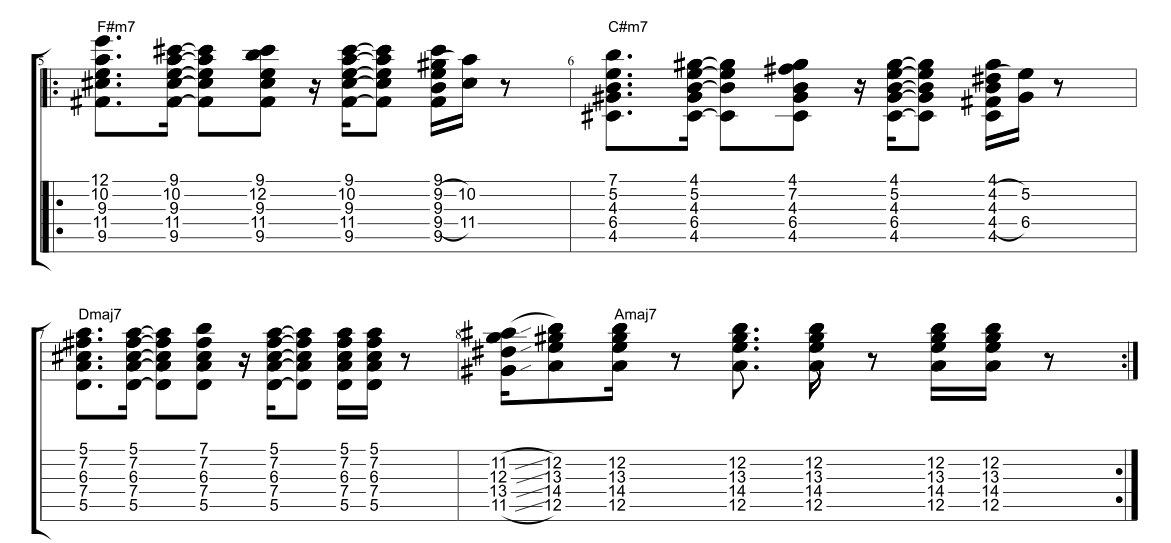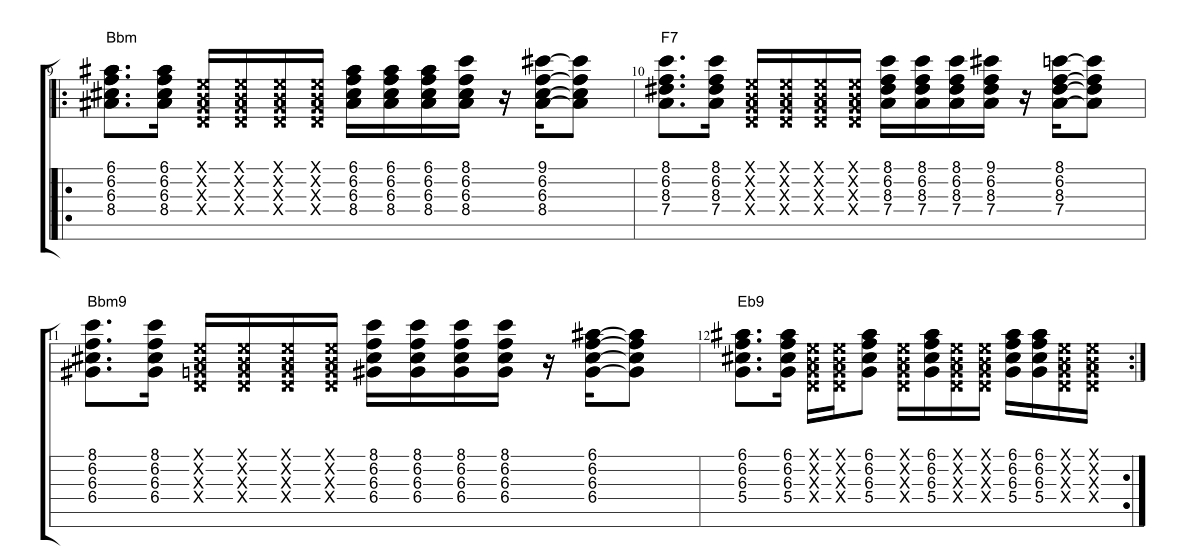Play Funk Guitar – Lesson Nine
In today’s lesson, we are looking at Barre chords as they can create big sounding funk rhythm guitar parts. In today’s examples we examine barre chord riffs applied with root notes on varying strings. Be sure to check your new barre chord shapes for any unwanted muted notes by picking through each note of the chord individually.
Funk Guitar Example 1 – 6th String Barre Chords
Example one applies some barre chord shapes with a 6th string root. The minor 7th and major 7th chords are a staple of funk guitar playing, and the dominant 11th chord included at the end of bar two is also a popular choice. Your picking hand should remain relaxed throughout this lick. If you are struggling to add the muted parts, start off by leaving them out and add them in when the rest of the progression feels comfortable.

Funk Guitar Example 2 – 5th String Barre Chords
Nile Rodgers once again takes centre stage in example two. This example uses only the minor 7th and major 7th chord shapes, but adds melodic interest by adding in variations using the little finger. When applying barre chord shapes from the 5th (A) string root, keep in mind that the low E string needs to be muted. This is achieved by pushing the edge of your first finger into the E string to dampen and mute the string. Be sure to watch the YouTube video to see how I apply this technique.

Funk Guitar Example 3 – 4th String Barre Chords
In example four I have created a slightly more complex funk pattern around the key of Bbm. The descending chromatic note pattern on the D string is combined with a melodic high E string part. Learn each chord shape individually and practice the changes with a metronome. Creating rhythm guitar parts that have a D string root note creates space for other band instruments to be heard, especially the bass guitar.

Recommended listening
For classic Michael Jackson-style guitar licks, I recommend buying the album “Number Ones.” My favourite track on that album being “Rock With You.”
Subscribe on Youtube
Make sure you log on and subscribe to our new YouTube Channel, dedicated to bringing you the finest free guitar lessons.
Guitar Lesson Video Transcription
Hi everyone, Simon here once again for Fundamental Changes. Today we’re looking at the next in our series about funk guitar parts. Let’s go and have a look at 3 examples just after this.
[guitar playing]
Today’s lesson is about taking chords, but on different string roots. We’re going to look at a set of chords on the 6th string root or the E note, we’re going to have a look at a string of chords on the A root or the 5th string, and then a series of chords on the D root.
You can see how, throughout this lesson you can build funk guitar parts, but with different root notes and different bar chords. Example 1 then here today is all around our E string, or 6th string root note.
We’ve got the chords of a G minor 7, which is your 3rd fret bar chord with your minor shape -E minor shape minus your little finger. You end up with 3-5 and 3s all the way across. You’ve got your A minor 7, which is the same shape you did in G, just up 2 frets, at the 5th fret.
You’ve got your B flat major 7 here, which is 6, nothing, 7-7-6, nothing, and then on the very end you’ve got your C 7. Some of you may call this B flat over C, which is your 8, nothing, 8-8-6. I’m applying quite a nice, gentle funk pattern throughout these chords here.
These are some 6th string root, big chunky bar chords for you to work on. Let’s go and have a look at Example 2, which is around the 5th string root, or the A string.
[guitar playing]
There was our A string, or 5th string root bar chords. Today these chords are around F sharp minor 7, which is our 9th fret bar chord with our A minor shape minus the little finger, nothing on the 6th, 9-11-9-10-9, then moving that identical shape back to the 4th fret for our C sharp minor 7, then we’ve got out D major 7, which is nothing on the 6th, 5-7-6-7-5, and then that same shape at the 12th fret for our A major 7.
This one is very much in the style of Nile Rodgers and Chic. By now, you guys know how much of a fan of his I am, but showing you how you can break up your neck using just 2 chord shapes: the minor 7 and the major 7 covering quite a lot of ground.
Usually, we’re used to just bouncing between strings, going 6th string, 5th string, but using 1 string can give you some new ideas and get you around the neck, and also get you used to shapes on different bar chord roots.
Let’s go and have a look at Example 3 around the D string.
[guitar playing]
We’ve got some pretty silky smooth chords going on here around our D string or 4th string root. We’ve got a B flat minor 7, top 4, which is going to be nothing, nothing, 8-6-6-6, then we’ve got this type of F 7 here, which is really rather cool. It’s descending, something you might see as a type of A dominant or A diminished, but for now, we’re going to call it an F 7 – nothing, nothing, 7-8-6-7, then on the top strings we’ve got a B flat minor 9, nothing, nothing, 6-6-6-8, and then we’ve got a top part of an E flat 9. Again you could call this a minor 7 flat 5 from a different root note, but we’re going to call it and E flat 9 top part, nothing, nothing, 5-6-6-6.
Often these chords can be called different names. It’s fine if you name them something different. I’m just trying to keep them consistent throughout these series of lessons, because we’ve already learned our dominant 9 chord there so you’ll be able to recognize that one.
This one has got a more upbeat funk pattern to it. Sounds pretty cool, these 4th string roots.
What I want you to think about is create rhythm guitar parts and where your root notes are: are they on the 6th, or are they on the 5th, or are they on the 4th string, and the obviously you can blend them up. You can go between the 2 string sets, but you can build whole guitar parts by just using 1 string as your root note basis for your whole parts. I really hope this has given you something new to add in your funk rhythm guitar playing.
Any comments, questions, or ideas, please put them below as I and Joseph both read them, and we love to hear from you too. Take care, speak to you soon.
Hi everyone, thanks for watching this Funk Guitar Lesson. I hope you got something from it. Please go and check out Joseph’s website Fundamental Changes, his books on Amazon that are fantastic, and come and have a look at my YouTube channel SDPguitar, for way more free videos to inspire you in your playing.
Take care, see you next time.
“The artists you work with, and the quality of your work speaks for itself.”
Tommy Emmanuel
© Copyright Fundamental Changes Ltd 2024
No.6 The Pound, Ampney Crucis, England, GL7 5SA
